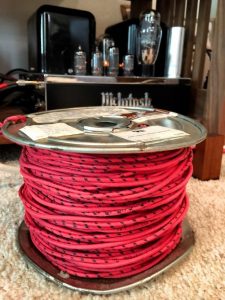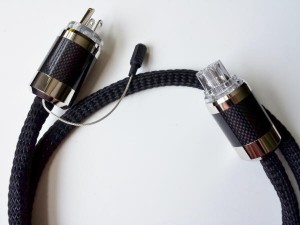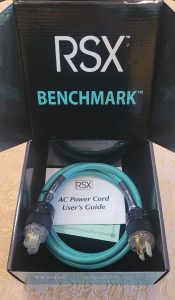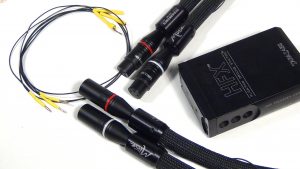It seems that High Fidelity was one of the first magazines in the world, and surely outside Japan, that received Acoustic Revive cables based on PC-Triple C copper and published such a review (No. 126, October 1st 2014). The Japanese magazine Audio Accessory, printed their review a month before us in their September issue, dedicated to cables. They described technical aspects and presented first PC-Triple C (Pure Copper-Continuous Crystal Construction) cables, including those of Acoustic Revive. Here we have the latest Acoustic Revive interconnect and power cable.
This was a special moment for Japanese audio market that was significantly influenced by the decision of Furukawa Electric announced on March 4th 2013, right before the 130th anniversary of company's existence, that they stop manufacturing PCOCC copper. PCOCC reads as: Pure Crystal by Ohno Continous Casting.
It so happens that in the same issue of High Fidelity, that you're reading right now we also test cables of another Japanese manufacturer, actually one of the biggest there are—Furutech. We reviewed the FA-13S interconnect, FS-15S speaker cable and FP-TCS21 power chord. This set belongs to the same, relatively inexpensive line with a dark green PVC sleeve, but there is a twist: interconnect and speaker cable still utilized and outstanding stock of μ-OFC wire while power chord is made of PC-Triple C.
Acoustic Revive when compared to Furutech in terms of production and sales volume is on a quite different level. Here a large part of production process is still carried out by hand, so output capabilities are limited. AR doesn't have large warehouse as they don't keep a lot of products and materials on stock, and thus almost right after Furukawa's decision they could replace OCC copper with a new type. I elaborated on this story in my review in October 2014, and in my Furutech review I repeated part of that information and elaborated even more, so let me just shortly remind you that PCOCC was invented by professor Atsumi Ohno of Japanese Chiba Institute of Technology. He found out, after extended research, that casting was a better method of manufacturing copper wire that drawing, as this way a wire with ultra-long copper crystals was made with 125 m of length and diameter of 0,1 mm. This process was named after its inventor, thus Ohno Continuous Casting (OCC).
Furukawa, that acquired right to use this process, developed a process of manufacturing audio cables using OCC wire with copper purity exceeding 99.9997%. The new version of the conductor was patented under the name Purity Copper OCC, or PCOCC. Another branch of the company, FCM (Fine Chemicals & Materials), developed another solution that potentially might be even better than PCOCC, a PC-Triple C copper. Forging Process Copper is compressed to 70% by the gradual application of pressure with a fixed angle and direction in tens of thousands of forging operations. Forging can easily be associated with traditional Japanese way of making katanas—that is why one can find katana's blade in Acoustic Revive's advertisements.
PCOCC wasn't the only type of copper used by Japanese audio cables manufacturers and yet abandoning its production affected everyone. So today in Japan apart of PC-Triple C based cable one can also find those using HiFC copper (Zonotone, Ortofon) and C1011 (Shioda Cable).
The HiFC—High-Performance Pure Copper Wires—is manufactured by Hitachi Metals, Ltd., part of a larger Hitachi corporation. Instead of trying to achieve highest possible purity they decided to pursue an optimal structure of the wire. HiFC is a soft copper with a characteristic almost equivalent to 6N standard (around 99,9999% purity). It is made in a similar process to OCC, meaning by continuous casting and hot rolling and its special characteristic was achieved by adding trace amounts of titanium into copper.
C1011 is just a OFC, but made using a special process, that introduces a much more orderly crystal grain structure to this material. It is made by the same manufacturer as the HiFC, Hitachi Cable Co., Ltd. It's purity is rated as >99,99%. C1011 is also manufactured using casting and hot rolling. A final effect of these processes is a Type 1 special copper.
RCA-1.0 Triple C-FM (1.8x1.4)
We have dealt with RCA-1.0 Triple C-FM interconnect already before while performing a review I mentioned before. This time we received its another, special version, made with a thicker, oval conductor Ø 1,8 x 1,4 mm. They used the same material, PC-Triple C by FCM, but AR's cables are hand-made, using their own configuration and using custom made connectors. Interconnect features a pseudo-balanced design with a hot and return runs realized with identical, single-core wires. Shielding is provided in the form of a goosebump-type copper sleeving with Teflon coating, covered with a black mesh. Production of this element is complex and expensive and its carried out by Shinagawa Business and Industry Ltd. This element limits flexibility of this cable.
Cable features high quality, rhodium-plated RUR-1 connectors, custom made by another Japanese specialist, Matsukin Ltd. The main body of the connector is made of copper and rhodium-plated, and the cap is made of duraluminum 2017. All metal elements undergo cryo-treatment. No soldering is used—wires are fixed using gold-plated screws.
When we disassemble his RCA plug, we will see inside, on the "positive" conductor, a small, green "roller". This is not an ordinary ferrite ring but rather an expensive component called FINEMET (hence the 'FM' in the cable name). The owner of the patent and supplier of finished products that use this material is Hitachi Metals, Ltd. Finemet is an amorphous metal obtained by rapid cooling of a molten alloy, which comprises Fe, Si, B, and small amounts of Cu and Nb. By heating the alloy to a temperature higher than its temperature of crystallization, the metal changes its structure to nanocrystalline.
POWER REFERENCE Triple-C
Acoustic Revive power distributor featuring PC-Triple C cables with Schuko sockets is under development. But power cables featuring this type of copper are already available—these are top Power Reference models. We did a review of these cables sporting PCOCC conductors in November 2010, so a few years back (No. 79). After that review the only change this model underwent was a replacement of plugs with different ones. As soon as Furutech presented FI-50 NCF(R) ones, Acoustic Revive decided that it was IT.
As you've probably noticed the letter ‘FM’ are no longer part of the model name, because FINEMET noise suppressors were not used this time. Cables feature large diameter solid-core copper conductors which limits their flexibility. But at the same time it is relatively easy to bent them—one just does it as with any thick copper wire. Wires feature special isolation—a silk tube made by Ebisawa Corporation. An external layer is the same as in interconnect—a copper tube. Cables are hand-made by skilled professionals.
TEST METHOD
I compared Acoustic Revive cables using A/B/A comparisons with A and B known. As my reference for an interconnect I used: Siltech Triple Crown, Tellurium Q Silver Diamond and Acoustic Revive RCA-1.0 Triple C-FM. These cables connected Ancient Audio Lektor AIR V-edition CD Player and Audio Tekne TEA-2000 phonostage (with Air Force III turntable as a source) with Ayon Audio Spheris III linestage. Power cable was compared to Harmonix X-DC350M2R Improved-Version and Tara Labs The Omega Evolution AC. All were used to power Ancient Audio Lektor AIR V-edition CD Player.
SOUND
Recordings used for this test (a selection)
- Alan Silva and his Celestial Communication Orchestra, Luna Surface, BYG Records/Sunspots SPOT 539, „Actuel 12", CD (1969/2003)
- Blood, Sweat & Tears, Child is Farther To The Man, Columbia Records/Audio Fidelity AFZ5 195, Limited Edition No. 0115, SACD/CD (1968/2014)
- Cream, Disraeli Gears, Polydor/Universal Music LLC UICY-40023, Platinum SHM-CD (1967/2013)
- Francesco Landini, The Second Circle, perf. Anonymous 4, Harmonia Mundi HMG 507269, „hm Gold", CD (2001/2013)
- Frank Sinatra, No One Cares, Capitol Records/Mobile Fidelity MFSL-1-408, „Special Limited Edition No. 186", 180 g LP (1959/2012)
- Mikołaj Hertel, Epizod A, GAD Records GAD CD 035, CD (2015)
- Semafor Combo, Semafor Combo, OBUH V30, 180 g LP (2012)
- Sonny Rollins, Sonny Rollins on Impulse!, Impulse!/Esoteric ESSI-90134, SACD/CD (1965/2015) w: Impulse! 6 Great Jazz, Impulse!/Esoteric ESSI-9013/8 (2015)
Listening to Acoustic Revive cables was for me personally a particularly important element of this year's "Japanese issue" of High Fidelity magazine. I've been using cables made by this manufacturer for many years myself while reviewing many different components, and I also use an interconnect in my headphone system. Power distributor works in my main rig. It also features many anti-vibration accessories with AR logo on them such as: platforms, isolation elements, anti-vibration plugs for RCA outputs, demagnetizer, negative-ion generator, ultra-low frequency pulse generator, and for all connector areas I regularly use ECI-100 spray. I personally know and value the owner of this company, Mr Ken Ishiguro, who, by the way, visited us in Cracow and participated in Cracow Sonic Society meeting.
I was a bit concerned when I heard the news about replacing a material AR cables was made of with another one, as each such radical change force by external factors bring some uncertainty. Even more so because PC Triple-C copper 'behaves' differently than PCOCC one.
For the latter I would use a comparison to golden CDs. I hope that most Readers understand this reference—it's a bout warm, liquid, rich sound with remarkably smooth treble and a powerful, nice bass. This type of sound is particularly enjoyable, it allows listener to relax and rest while listening.
At the same time one has to accept the fat, that record plated in such a way won't offer many surprises. A differentiation is simply limited, and the whole presentation is marked with, lets say, 'golden' signature. That is why some Japanese companies never used gold, they prefer aluminum. That's what PC Triple-C cables have to offer: a fast, energetic, resolving presentation that sometimes lacks refinement especially in the midrange area. Treble on the other hand is wonderfully 'lit up', crisp, but bass is not as rich as offered by PCOCC cables.
As it turned out a particular application also matters. Yes, the previously reviewed Acoustic Revive cables fitted this description well. But they were not too bright and bass was not too 'light'. It was a fast, resolving, open sound. Power Reference chord introduces this type of changes into the sound too. I think that in this particular case replacing plugs and later also conductor translated into biggest quantitative change.
Previous flagship power cables offered by Ishiguro-san were really good, offered interesting sound and fulfilled their job very well. But then I was under impression that it was the power cable that was the weakest link in the whole AR cables loom. The new products are completely different. I quickly noticed how resolving they were, how well they differentiated recordings. They deliver music in a particularly open way but with a powerful bass. Sound has proper weight and yet it is also open and fast. It is really difficult to pinpoint a part of the range that might dominate the rest, or even a particular accent on some frequency. They nicely 'disappear' from the system, apart for a slight emphasis placed on the leading edge in the upper midrange, which follows a path set previously by interconnect and speaker cable.
I described Power Reference's 'gain' as the biggest quantitative one, but the biggest qualitative change was introduced with RCA-1.0 Triple C-FM (1.8x1.4) interconnect. It was this cable that provided me with the real insight into this type of copper's quality and thus into the future of audio cables. Just like many manufacturers has some issues with KT120 tubes for some time after they were introduced, now cable producers have to learn how to use a full potential of this new copper conductor. Today it seems that Furutech and Acoustic Revive already do a great job. Listening session with this interconnect featuring thicker, oval-shaped conductor revealed something more though—a much richer, denser sound than the one deliver by the 'regular' cable. Images are large and substantial and at the same time their depth is conveyed in a better way. Everything carries more energy, more power which creates an impression of louder presentation—maybe 1-1,5 dB louder. Obviously it is a subjective impression but it makes listening more interesting, more exciting.
Sonic character reminded me of that of PCOCC cable, but it was quite the same. I've mentioned a sound aluminum CD like as my reference to Triple-C copper. The oval-shaped AR conductor offers something even different—something I would reference to the sound of XRCD. These are pressed on aluminum too and yet they offer richer, deeper, more, so to speak, analogue sound than other 'aluminum' based compact discs. That's how I perceived this interconnect. I could feel more presence of the musicians in the room, also because of substantial bass foundation. Depth of the soundstage seems slightly smaller—whatever happens in the front of the stage is more important than things happening in the back. Yet, it is remarkably resolving and thus recording's acoustics, reverbs are there, although one has to disengage from music itself to notice that.
Summary
The Power Reference cable proved that this Japanese manufacturer has made progress in this area. It is a valuable element of the whole Triple-C series, that I had reviewed before. The 1.8x1.4 interconnect is even something more, it represents even higher class performance with its tonal richness, great imaging and particularly energetic presentation. It's the case where adding a component to a system offers 'more music in music'. Well done!
Acoustic Revive
RCA-1.0 Triple C-FM (1.8x1.4)
POWER REFERENCE Triple-C
Prices (in Poland): 8900 zł/0.5 m | 17 900 zł/2 m
SEKIGUCHI MACHINE CO., LTD.
Yoshi Hontai | MuSon Project, Inc.
MADE IN JAPAN
Provided for test by: MUSON PROJECT, Inc.
Text: Wojciech Pacuła | Images: Wojciech Pacuła
Translation: Marek Dyba
















































